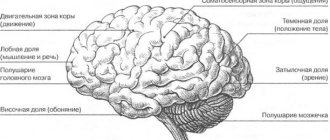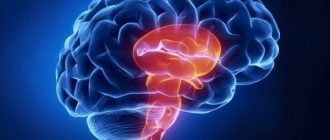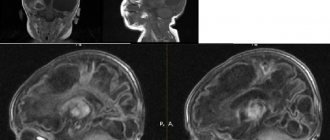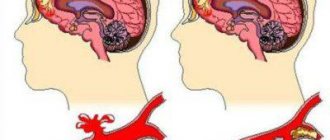A diagnosis such as organic brain damage is very common today. This is due to the fact that this is not just one disease, but a whole group of different pathologies that are characterized by at least some structural pathological changes in the brain tissue.
According to neurologists, such a diagnosis can be given to 9 out of 10 people of any age. But, fortunately, most often the organic changes are so minimal that they have absolutely no effect on the functioning of the brain or the patient’s well-being. In the case when symptoms of such a disorder begin to appear, it can be assumed that most of the brain has undergone pathological changes (approximately 20-50%), if the number of damaged neurons exceeds 50%, then persistent pathological symptoms and syndromes develop, which we will discuss below.
Video lecture on organic brain damage:
Causes
Causes of encephalopathy:
- Brain injuries (post-traumatic encephalopathy). Also known as “missed beat syndrome” (and related “chronic encephalopathy”). Often observed in athletes: boxers, American football players. Numerous injuries lead to the accumulation of amyloid in the brain.
- Pathology of pregnancy and childbirth in the mother (perinatal encephalopathy).
- Atherosclerosis, hypertension, dyscirculation (vascular, hypertensive).
- Inflammatory changes in the walls of blood vessels[6][ unauthorized source?
] - Chronic intoxication with alcohol, heavy metals, medications and poisons (toxic encephalopathy)
- Addiction
- Severe liver and kidney diseases (hepatic encephalopathy, uremic encephalopathy)
- Radiation (radiation injury)
- Ischemia (chronic oxygen starvation of the brain)
- Diabetes
- Venous (increased intracranial pressure)
Symptoms of encephalopathy
Symptoms of encephalopathy are very diverse.
The most common symptoms of encephalopathy are:
- disorders of memory and consciousness;
- lack of initiative;
- headache;
- desire to die;
- dizziness;
- noise in the head [7] [ unauthorized source?
]; - depression.
Patients with similar symptoms of encephalopathy often complain of fatigue, irritability, absent-mindedness, tearfulness, poor sleep, and general weakness.
At the same time, when examining them, apathy, viscosity of thought, verbosity, narrowing of the circle of interests and criticism, daytime drowsiness, difficulty pronouncing certain words and other symptoms are noted.
Consequences
With or without therapy, the following outcome is possible:
- Recovery occurs when the brain damage is insignificant, the manifestations of the disorder are mild and have practically no effect on the body.
- Disability and incapacity for work, when a person cannot care for or provide for himself.
- Fatal outcome. Possible if the disease occurred in old age, and the therapy was carried out by an unqualified doctor.
If pathology is identified in time and proper treatment is prescribed, then newborns have a greater chance of a full recovery. Positive dynamics in therapy for older people is observed only in half of the cases.
Types of encephalopathy
- HIV encephalopathy (English)Russian. (HIV dementia)
- Hypertensive encephalopathy (English)Russian.
- Glycine encephalopathy (English)Russian.
- Encephalopathy
- Mitochondrial encephalopathy (MELAS syndrome)
- Perinatal encephalopathy
- Hepatic encephalopathy (hepatic coma)
- Subcortical atherosclerotic encephalopathy (Binswanger disease)
- Acute hepatic encephalopathy (Reye's syndrome)
- Toxic encephalopathy (English)Russian. Manganese encephalopathy
- Creutzfeldt-Jakob disease
Organic diseases of the brain. exogenous and somatogenic mental disorders
This chapter discusses diseases that arise as a result of primary or secondary damage to brain tissue, i.e. organic diseases. Although the division into organic and functional disorders is widely used in medicine, in some cases it is not possible to draw a clear line between these concepts.
Thus, in schizophrenia, traditionally considered as a functional psychosis, nonspecific signs of organic changes in the brain are often found.
The authors of ICD-10 emphasize that the term “organic” does not imply that in all other mental illnesses there are no changes in the structure of the nervous tissue, but indicates that in this case the cause of brain damage or the nature of such damage is known.
In contrast to functional mental disorders, when diagnosing organic diseases, methods for studying the structure and function of the brain are widely used (see sections 2.2-2.4).
However, the absence of clear signs of pathology during paraclinical examination does not reject the diagnosis of an organic disease.
In this sense, in psychiatry the term “organic” is used somewhat more widely than in neurology, and the diagnosis of organic diseases is largely based on their general clinical manifestations.
The main distinguishing signs of organic diseases are clear memory impairment, intellectual impairment, emotional incontinence and personality changes. To refer to the entire complex of organic mental disorders, the concept of psychoorganic syndrome , described in section 13.3.
In accordance with the leading etiological factor, it is customary to divide organic diseases into endogenous and exogenous. It is assumed that psychosocial factors cannot be the main cause of organic diseases.
However, one should always take into account the conventions of accepted classifications, since individual manifestations of psychosis reflect the entire complex of interaction of external biological and psychological factors, heredity and constitutional make-up.
Despite the huge variety of causes that can cause organic brain damage (infections, intoxications, injuries, tumors, vascular diseases, etc.), there is a significant similarity between the manifestations of various organic diseases.
One of the attempts to explain it is the concept of an exogenous type of reaction, proposed by the German psychiatrist K. Bongeffer (1908, 1910). His works express the opinion that in the process of phylogenesis the human brain has developed a limited number of standard reactions to all possible external influences.
Thus, in response to a variety of damaging influences, similar reactions arise. K. Bongeffer's conclusions were based on an analysis of the manifestations of infectious, intoxicating and traumatic psychoses. Appearance in the 20th century.
new toxic substances, infections (for example, AIDS), previously unknown damaging factors (radiation damage) demonstrated the fundamental correctness of the main provisions of this concept.
Exogenous type syndromes include:
- asthenic syndrome
- syndromes of impaired consciousness (delirium, amentia, twilight disorder, stupor, stupor, coma)
- hallucinosis
- epileptiform paroxysms
- Korsakov's amnestic syndrome
- dementia.
It should be taken into account that the listed syndromes are not typical for endogenous functional psychoses (schizophrenia and MDP).
However, among the manifestations of organic diseases, there may also be disorders similar to the manifestations of endogenous psychoses - delirium, depression, catatonic symptoms.
To some extent, the appearance of such symptoms can be explained based on the theory of evolution and dissolution of mental disorders (see section 3.5 and table 3.1).
The leading syndrome may indicate the acute or chronic nature of the disease, indicate the initial manifestations of the disease or its final stage (outcome). Thus, asthenic symptoms are observed in the initial period of slowly developing diseases or in the period of convalescence.
Abundant psychotic productive symptoms (confusion, delirium, hallucinosis) often occur during the acute onset of the disease or during its subsequent exacerbations.
The end states correspond to such negative disorders as dementia, Korsakoff's syndrome, gross personality changes, often combined with a violation of criticism, euphoria and complacency.
In ICD-10, the taxonomy of organic disorders is based primarily on the identification of the leading syndrome - heading:
- F00 - F03 - dementia,
- F04 - Korsakov's syndrome,
- F05 - delirium,
- F06 - other productive organic mental disorders (hallucinosis, delirium, catatonia, depression, asthenia, hysteroform symptoms),
- F07 - personality changes due to organic disease.
This chapter does not describe some diseases that in fact should also be considered organic.
Thus, epilepsy [G40] in ICD-10 is classified as a neurological disorder, but this disease is characterized by mental disorders that correspond to the concept of psychoorganic syndrome (dementia, personality changes), and this can be taken into account in the diagnosis in the form of an additional code.
Psychoorganic syndrome and exogenous type syndromes often arise as a result of substance abuse (alcoholism, drug addiction, substance abuse), however, due to the special social significance of these diseases, in ICD-10 they are separated into a separate class and discussed in Chapter 18.
, please select a piece of text and press Ctrl+Enter.
Source: https://auno.kz/uchebnik-po-psixiatrii/133-organicheskie-zabolevaniya-golovnogo-mozga.html
Treatment
Treatment of encephalopathy is a long-term course, taking into account the severity and duration of the disease, as well as the age and concomitant diseases of the patient.
Diagnosis of encephalopathy is based on:
- Neurological status
- Psychological status
- Test results: blood
- cerebrospinal fluid
Such courses of treatment, which are carried out both on an outpatient basis and in a hospital setting, require from 2 to 3 during the year, depending on the severity of the encephalopathy.
Treatment methods for encephalopathy:
- Drug therapy (non-steroidal anti-inflammatory drugs, analgesics, hormones)
- Metabolite, vascular, antioxidant therapy
- Blockades - injections of drugs into the canal cavity
- Manual therapy (muscle, joint and radicular techniques)
- Osteopathy
- Physiotherapy (UHF, SMT)
- Therapeutic physical education (PT)
- Surgical treatment
These treatment methods and therapeutic actions are used depending on the severity of the manifestations and causes of encephalopathy in the patient.
In each specific case, drug therapy is prescribed individually depending on:
- Causes of encephalopathy
- Disease severity
- Predominant symptoms
Diagnostics
Recognizing an organic lesion in the central nervous system is not easy. After all, this is not the presence of some kind of formation in the tissues - for example, a focus of cancer. Changes, as a rule, affect the entire organ or a significant part of it - the primary disease gives its complications. Specialists establish the relationship between the patient’s complaints and the objective changes they obtained using neuroimaging methods.
Magnetic resonance imaging has proven itself to be excellent - in pictures in different projections you can carefully examine lesions of the brain parenchyma, choroid plexuses, as well as cranial nerves and skull bones. However, a more accessible study is computed tomography.
There are different options for examining vascular lesions - angiography, rheoencephalography, or ultrasound. As needed, contrast solutions are introduced into the vein, which make the image on the monitor screen clearer - to understand the nature and area of the organic lesion.
Laboratory tests help to understand the nature of disorders in the central nervous system - blood tests for biochemical parameters, hemoglobin and red blood cell concentration, as well as tumor markers and hormonal levels. It is in the totality of information - a neuralgic examination and examination results that the doctor will be able to carry out a differential diagnosis of damage to the central nervous system in the patient.











